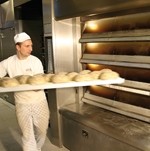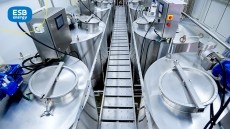Beat the cost rises

Food companies face an energy double whammy. Not only do most manufacturers need gas, electricity or steam to heat, cook or sterilise their products, the majority also need energy to cool, refrigerate or freeze them afterwards.
The bad news is that energy costs have risen as a proportion of total operating costs - now 12.2% compared with 9.6% six months ago. The result is that many manufacturers are turning to some form of energy management to keep their ever-rising gas and electricity bills down.
And the picture is fairly gloomy. According to the latest survey of industrial energy use from npower business, part of RWE npower, the UK's leading electricity supplier, most companies (62%) have seen their energy costs increase over the last six months.
The Business Energy Index, npower's biannual report on energy issues, predicts that energy costs over the next six months will rise by a further 8.5% and by 9% over the next three years.
Now these may not be the steepest rises forecast for energy prices in recent years, says npower, but the continued volatility and uncertainty in energy prices means that 94% of companies say they are actively seeking to improve the monitoring and management of energy. According to the Business Energy Index, nearly half (45%) say they now employ full-time staff for energy management, and 60% say they use building energy management systems.
Companies have been forced to act, suggests David Lewis, head of energy solutions at npower business, because of the increased volatility in the energy market compared with two or three years ago, making energy a lot more expensive for customers. "That has focused their minds on energy costs and pushed energy up the agenda on to the financial director's desk and into the boardroom."
Energy management is about ensuring that your processes, your equipment, and your plant use energy better. Despite their energy double whammy, food companies have an advantage over many other industries, says Lewis. Most of their processes and equipment will now be relatively well monitored to comply with food traceability and food safety reporting requirements.
"So they have the opportunity to use this data wisely to find out where they are not operating effectively. That should be the main focus. Use the data you have got to make sure that the equipment you have is working effectively and that there is not a lot of energy wastage, such as running machines when not required or leaving them on during periods of inactivity."
Since the majority of processing in the food industry is batch production, says Lewis, there will always be opportunities to ensure that all the systems in a process are interlinked and scheduled correctly and operate properly.
"What's easiest for the people on the shopfloor to operate isn't always what's the most cost-effective or efficient. But with better working practices and better maintenance, 5% savings in energy costs are not unrealistic - and you could be looking at 10% or more.
"At npower, we focus on how a company uses its energy in its plant. We are not trying to tell them how to operate their processes differently. We first establish what the energy load demands are - hot water, steam, hot air, temperatures and pressures and so on. Then we work backwards through the distribution system to the generation equipment such as the boilers. The aim is to make sure everything is optimised, rather than telling the customer 'You need a new boiler'."
The aim is to measure and understand their energy demands, then target reductions, says Lewis. "Reduction always pays back the best and the quickest. Better, more flexible, energy procurement is important, but it's a short-term gain; once you get to the end of the contract you've got to start again. But with energy saving, once you've gained it you should never lose it."
Monitoring energy use
However, although food companies may have been forced by food traceability rules to monitor their processes and equipment, that doesn't necessarily mean that they are all using the data they collect to measure energy usage and improve energy efficiency, suggests Richard Porter, industry manager with IT supplier Siemens Automation & Drives.
A couple of decades ago, new processes, production lines and packaging lines would often be installed as isolated islands of automation, says Porter, with little or no IT thinking given to linking up their individual machine control systems. That meant that a company's expensive enterprise resource planning system (ERP), the corporate IT system that attempts to match orders to resources, couldn't talk to the machines on the shopfloor and vice versa.
MES helps manage consumption
Some companies are fortunate in having an IT layer between the machine controls and the ERP system, known as a manufacturing execution system (MES). A full-blown MES will cover everything from scheduling orders on production lines and recipe management, through to production, dispatch and data collection and analysis.
And if used properly, an MES should give a food company the ideal way to gather and analyse data about shopfloor energy usage, says Porter.
But too few companies have the right parts of an MES installed to do this. "Everybody has some form of manufacturing execution system. They have always had a scheduling system; they've always had recipe management; they have always had some data collection. But these have tended to be disparate, individual islands of automation." The only link with higher-level ERP-type systems, says Porter, was manual: paperwork.
"What a proper MES does is take all these middle-layer software applications and tie them all together in one system. And some of the data will let you know how you are using your energy and how you can use it better."
Porter is currently working with a bakery to install a full MES with the aim of improving the energy use of the ovens. The potential energy savings are a significant element in the benefits case for implementing the MES solution, he says.
"Currently, when the operators come in in the mornings they switch on the ovens, and then they start production two hours later. That means they are heating the ovens for no good purpose for quite a while. By having a proper MES solution in place, they will know when ovens are required because they will receive an order from the ERP system to start producing product at 10 o'clock.
"So the MES can automatically schedule the start of the ovens at 9.30am so that they are up to temperature just as the food product hits the ovens. Similarly, when the MES senses there is no more product to come, it will start to shut down the ovens. The ovens are 50m long so it can start shutting down the burners as product starts to leave the oven. Because we have that feedback from the MES, the bakery will know exactly when it should or should not be burning energy."
Often the problem with many food companies, says Porter, is that they will have an MES in place but they are not focused on using it to monitor energy consumption.
"Their priority is to get product out of the door. In that bakery, for example, the operators would be in big trouble if the ovens were cold and not switched on so that they couldn't start production. Their job is to make product. I doubt if many operators in food companies have a target for reducing energy," he says.
Also, he adds, very few companies have a full-blown MES in place. According to the ISA-95 standard for what an MES should encompass, laid down by the Instrument Systems and Analysis Society, an MES can have nine functions. These are divided into four stages: how to produce; what can be produced; when and what to produce; and when and what was produced.
Most companies will only have implemented three or four functions, says Porter, involving the production performance aspects of MES, that is, when and what was produced. "It means that when they get their energy bill they haven't got the data to indicate where that cost comes from."
Porter suggests companies should implement full MES to manage the scheduling/dispatch/execution functions as well so as to be able to manage their energy use - that bakery is an example of how these functions in a full MES can contribute to energy efficiency.
"By monitoring and knowing where you are consuming energy, you will get to understand where you are being wasteful and how you can use energy better," says Porter. FM
Key Contacts
- npower business 0121 703 3734
- Siemens Automation 0161 446 6400














